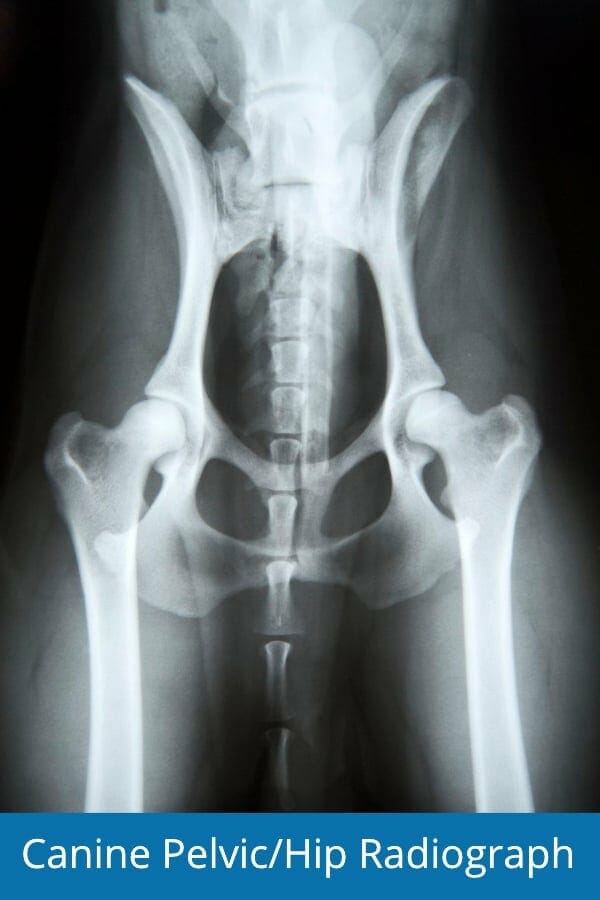Signs of arthritis in dogs can start subtly. Even the most proactive pet parent may chalk symptoms up to normal aging or “slowing down.” But as the condition progresses, the symptoms progress too, and end-stage arthritis can be completely debilitating. Integrative veterinarian Dr. Julie Buzby sheds light on the symptoms of arthritis in dogs—from early to late-stage arthritis—so you’re prepared to work with your vet and help your dog.

Is your senior dog slowing down? Many dog owners attribute this to normal aging and don’t think twice about it. But what if I told you that this change in behavior is one of the signs of arthritis in dogs?
If your internet search history includes, “how to tell if my dog has arthritis,” read on for my top 12 signs of dog arthritis, and how arthritis can be diagnosed and managed.
What is arthritis in dogs?
Arthritis refers to pain, inflammation, and stiffness of the joints. Just like in humans, arthritis in dogs is caused by the breakdown of cartilage that lubricates joints and allows them to move smoothly.
Arthritis is very common in dogs and worsens with age. According to the Veterinary Information Network, up to 25% of dogs will be diagnosed with arthritis in their lifetime, and as many as 60% have evidence of arthritis on X-rays.
There are two main forms of arthritis. Rheumatoid arthritis (RA) is an autoimmune condition. Osteoarthritis (OA), also called degenerative joint disease (DJD), is the natural breakdown of cartilage in joints over time.
Osteoarthritis can be primary (related to old age and typical wear and tear on joints) or secondary (related to a previous injury to a joint, birth deformity, or prior orthopedic surgery).
Osteoarthritis in dogs is much more common than RA, so this article will focus on osteoarthritis in dogs, though signs of OA and RA can overlap. For simplicity, further mentions of “arthritis” will mean specifically OA.
What are the signs of arthritis in dogs?
Signs of arthritis in dogs are often subtle and can even start in younger dogs. Initially, you may only notice that your dog is reluctant to get out of bed in the morning or go for long walks. An arthritic dog may have difficulty navigating stairs and jumping onto furniture. Maybe your Labrador Retriever is avoiding going for swims they used to love.
As arthritis progresses, your dog may be very stiff throughout the day, take short, choppy steps, and struggle to get up and down. End-stage arthritis can lead to the inability to stand at all.
Let’s take a deeper look at 12 ways arthritis can affect dogs so that you will know how to tell if your dog has arthritis.

12 signs of arthritis in dogs
Because early signs of arthritis can be subtle, it’s important that we as pet parents monitor our dogs for behavior and movement changes. Even with treatment, arthritis is a progressive condition, but early intervention can slow the progression.
Let’s take a look at 12 signs of arthritis in dogs to watch for.
1. Limping or lameness
Dogs with arthritis hurt. Arthritic pain, like any other orthopedic pain, may cause a dog to limp on one or more legs. Generally, whichever leg is the most sore is the one we see lameness in, and it may not be the same leg each day.
Osteoarthritis commonly affects joints such as hips and elbows, which may be prone to congenital conformation issues or injury. If you notice your dog limping, something hurts, then it’s time to make a vet appointment.
2. Stiffness after resting
One of the earliest and most subtle signs of arthritis is a dog who appears stiff after lying down for some time. Not only can it take more time to get up, but also once the dog is up he or she may have “creaky joints” for a bit.
Arthritic dogs appear stiff because they are! Just like people may feel a little sore or have stiff joints when first waking up, arthritic dogs may take a bit to “get going” after a rest.
Pay close attention to how your dog moves after he or she first gets up from sleeping. Sometimes symptoms of arthritis are most evident first thing in the morning.
3. Exercise intolerance (i.e. reluctance to exercise)
What is “exercise intolerance?” I don’t mean that the dog is lazy; this is different from my desire to hit the snooze button when I set my alarm to work out in the morning. Exercise intolerance refers to a dog seeming reluctant to do daily activities he or she previously enjoyed.
Wanting to call it quits halfway through a normal walk, being less enthusiastic about swimming, or preferring an extra nap over a hike may be signs of joint pain. If Fido used to walk a mile every day and now is trying to turn toward home a half mile in, arthritis is topping my list of possible causes.
4. Difficulty rising
Dogs with arthritis may be slow to rise after resting. Holding arthritic joints in one position during sleep can make it difficult to stretch them out when they first wake up.
This sign may be especially evident in large-breed dogs (who are already more prone to arthritis). With a larger body mass to raise, arthritic joints may have a harder time simply fighting gravity. If you notice your older dog rising more slowly after sleeping, arthritis may be the cause.
5. Reluctance to move
If something hurts, it’s natural to try to avoid moving it. Moving stiff joints exacerbates osteoarthritis pain. Arthritic dogs often move less as OA progresses.
You may notice your dog jumping on and off furniture less, hesitating before climbing into the car or becoming less enthusiastic about a game of fetch. This is usually the type of “slowing down” I hear about from pet parents that is often my first clue to start to look for arthritis somewhere.
6. Difficulty jumping or climbing stairs
Navigating stairs uses different muscles than walking on flat ground. It moves joints in different ways and may require more effort for dogs with osteoarthritis. Reluctance to climb stairs especially is often one of the early signs of arthritis in dogs’ back legs, because going up puts most of their weight on their back end.
If he or she is developing arthritis, your dog may take stairs more slowly/delicately, or avoid them altogether.

Similarly, jumping—whether on and off the couch, into and out of the car, etc.—puts unique strains on joints. Jumping up takes a good deal of strength in the hind legs.
Jumping down doesn’t take as much effort, but it is a lot of impact on the front legs and back as a dog lands. This can be especially painful for dogs with osteoarthritis secondary to conditions such as IVDD or elbow dysplasia.
7. Sensitivity to touch or changes in temperament
If something on my body hurts, I don’t want anyone to touch it. That makes sense, right?
Painful dogs are often guarded around the areas that hurt. Many dogs with hind limb arthritis are very sensitive to their rear ends being touched. Sometimes this sensitivity lessens with pain management, but sometimes it’s a learned response and dogs may still avoid certain places being touched even once we’ve relieved their arthritis pain.
This sign is very important to watch for because dogs with arthritis pain can be more likely to bite. Dogs do not naturally just become more grouchy with age; many of these “old and cranky” dogs are painful!

As a mom, I’m hypervigilant about this symptom of arthritis, because often the victims of these bites are children. Kids aren’t always able to recognize or respect subtle signs of pain and aren’t always the best about affording dogs (or people) space.
These are not bad dogs, and these bites are not their fault. They hurt and someone is invading their space and touching painful parts of their body. Often their cues telling people to back off (such as anxious canine body language or growling) are unnoticed or ignored. This is a perfect storm that could lead to a bite.
We want to make sure that we observe earlier signs of sensitivity to touch so it doesn’t progress to a situation where a dog feels his or her only option left is to bite.
8. Licking, chewing, or biting the sore or inflamed joint
An arthritic dog may lick or chew on a sore joint to try to soothe it.
Licking a joint is an inconsistent and variable sign of arthritis in dogs. Some do it, but many don’t. So just because a dog is not licking or chewing on a joint doesn’t mean it isn’t painful. Also, some arthritic joints can be hard to reach, like the hips.
It is important to note that excessive licking does not necessarily indicate pain. Licking, especially paw licking, is often a sign of allergies in dogs.
9. Coat changes
Going hand in hand with excessive licking, sometimes we will see changes to the fur over dog’s joints if they are painful, particularly in lighter colored dogs.
Dogs’ saliva has iron-containing molecules called porphyrins. Licking or chewing a certain spot excessively causes a build-up of porphyrins in the fur, which can stain the fur rust-colored.
Interestingly, porphyrins are also found in tears, and are the culprit of red-brown tear staining seen in some dogs with runny eyes.
Fur color change from salivary staining or even hair loss over a joint can be clues that a dog is licking or chewing a spot that hurts.
10. Change in stride or posture
Arthritis limits the range of motion of affected joints. Because we often see arthritis in older dogs’ hips, knees, elbows, and shoulders, this reduced range of motion can change the way they walk and run. Arthritis in dogs may manifest as a short, choppy gait, a slower walk, and a smaller stride when running.
A dog with spinal arthritis may not only have a gait change, but also a hunched posture. Change in posture is not a normal part of aging, and usually indicates some element of orthopedic pain or other problem.
11. Whining or groaning
Some dogs will vocalize due to arthritis pain. I say some because not all dogs will, and I’ve heard a lot of people insist that their dog is not painful because he or she is not whining or crying. This is not true!
I often tell my clients that I broke my arm years ago. I didn’t cry all day every day while it healed, but it sure hurt! Absence of vocalization does not mean absence of pain.
Along those lines, all whining or crying in dogs does not come from pain. Dogs can vocalize from anxiety (including senior dog anxiety at night), stress, boredom, etc. Some dogs are just more vocal than others—looking at you, Huskies!
Dogs who whine or groan due to arthritis pain often do so with exertion—rising from lying down, going up or down stairs, jumping on or off furniture. It makes sense that dogs will be more likely to vocalize when doing things that hurt.
12. Muscle atrophy in hips and back legs
The most common place I see osteoarthritis in dogs is in the hind legs. Arthritis is often associated with hip dysplasia, cruciate ligament injury, or other joint diseases affecting the hind limbs.
When I examine dogs that I think may be suffering from arthritis, I always look at them from the back end. This allows me to notice any asymmetry between the muscles of the back legs, and to detect any muscle atrophy.
Feeling the muscles of the hind legs and testing range of motion during my physical exam is another way to look for signs of osteoarthritis.
Just like exercise helps to build muscle, disuse leads to atrophy. When a dog has stiff, painful joints, he or she will move them less. Muscle mass is very much “use it or lose it.” When dogs move less—guarding themselves from arthritic pain—their muscles will shrink.
Muscle atrophy takes time. We generally see the other signs earlier in the progression of arthritis, so it’s very important to pay attention to those changes to catch OA early. Marked muscle wasting is generally a sign of advanced or end-stage arthritis in dogs.
Early signs of arthritis in dogs
Catching arthritis early gives us the best chance of managing it long-term. More subtle symptoms can be tricky to identify, especially because they may only be intermittently present.
The earliest signs of arthritis are usually stiffness, difficulty rising, and limping or lameness. Often these signs are attributed to general aging, but they can be our first clues that arthritis is developing.
Any of the 12 signs listed above may indicate early arthritis. The most important thing is to watch for trends. Gradual changes are often hard to notice, so if you start to see any suspicious symptoms, carefully monitor if they’re worsening or becoming more frequent.
End-stage arthritis in dogs
Even with treatment, arthritis is a progressive disease. It will eventually get worse and can progress to advanced or end-stage arthritis.
Signs of end-stage arthritis in dogs
To some extent, signs of end-stage arthritis are just more pronounced or more frequent occurrences of the signs we have already discussed. A dog may be stiff for longer after rising or may call it quits on a walk sooner.
Since you likely live with your dog every day, it can be hard to appreciate subtle progression over time, but your vet can help make notes of where your dog is in the stages of arthritis.
More severe, end-stage arthritis also causes some additional signs. These may include:
- Restlessness
- Limping—potentially not always on the same leg
- Shifting weight when standing—dogs with hind limb arthritis often put more of their weight on their front legs
- Difficulty posturing to pee or poop, sometimes potty accidents
- Severe difficulty or inability to rise from lying down
- Shuffling gait
- Falling when walking or standing
Signs of end-stage arthritis can be variable and inconsistent. It’s important to pay attention to your dog’s clinical signs and check in with your vet frequently for evaluations and treatment adjustments.
Unfortunately, severe arthritis can progress to the point that it impacts a pet’s quality of life. If a dog is unable to rise or walk without significant pain, the pet parent may need to consider when to euthanize a dog with arthritis.
Symptoms of arthritis in dogs’ back legs
While it is certainly helpful to keep an eye out for general symptoms of arthritis, it can also be helpful to know how to localize which joints may be affected. Sometimes we can specifically identify signs of arthritis in dogs’ back legs.
Hip dysplasia and CCL injuries are very common in dogs, especially large breeds. Both of these conditions often lead to arthritis in the hind legs. Although signs overlap, symptoms specific to arthritis in dogs’ hind legs include:
- Difficulty rising from sitting or laying
- Difficulty climbing or jumping up
- Muscle atrophy of the hind limbs
- Shaking of the back legs when standing
- Shifting weight to the front limbs
- Licking or salivary staining on back legs
Arthritis symptoms in dogs’ front legs
Similarly, some of the signs we see in dogs with arthritis point us more specifically to the front legs. Dogs with elbow dysplasia, shoulder injuries, or some neck or back issues can have more pronounced forelimb arthritis. Signs include:
- Reluctance to jump down or go down stairs
- Head “bobbing” when walking—a sign of front leg lameness
- Muscle atrophy of the forelimbs, often seen in the shoulder region
- Shifting weight while standing
- Licking or salivary staining on front legs
Of course, this is not an exhaustive list, but may give some clues as to where your dog is hurting.
How is arthritis in dogs diagnosed?
Your vet will use a combination of information from you, physical exam findings, and diagnostic tests to determine whether your dog has arthritis, and how severe it is.

What to expect at the vet: Diagnosing arthritis in dogs
First and foremost your vet will take a history—a valuable part of every medical appointment, but especially critical when the patients can’t speak for themselves. Your veterinarian will ask you questions such as:
- What symptoms have you observed in your dog?
- How long has the problem been going on?
- Have you tried any treatments? If so, what was the outcome?
- When are your dog’s symptoms at their best? Worst?
- Has your dog experienced any injuries—current or past?
Next, your veterinarian will perform a thorough physical examination (PE). This will include a “nose-to-tail” hands-on evaluation. Typically, this will include taking your dog’s weight and getting your dog’s vital signs. The veterinarian will check your dog’s eyes, ears, mouth, and lymph nodes, listen to the heart and lungs, and palpate the abdomen.
Your vet may then focus specifically on your dog’s limbs and joints. This involves feeling the muscles of the legs and back, pressing on certain areas to check for pain, and testing range of motion of the joints. Although any joint in the body can become arthritic, the most common location for arthritis in dogs is in the hips and hind legs.
Symptoms of arthritis can be subtle in the early stages of canine arthritis, so it sometimes takes a trained eye to see it.
Your vet will look for a change in gait
A gait exam should be next. I often take my client and patient into the hallway or out to the parking lot for this. I tell them to pretend they are at Westminster as I observe the dog walk and trot. In this way, I can assess for subtle changes in gait to help localize pain.
The physical exam and history are step one. Diagnostics generally come next.
Arthritis in dogs: X-rays and more testing
Diagnostic tests, like X-rays, are an important piece of the puzzle in diagnosing arthritis and ruling out other causes of pain or lameness. Your veterinarian may test for tick-borne disease in dogs, which can manifest in painful joints and limping. Blood tests can also be important to check organ function before starting treatment for arthritis in dogs.
Arthritis often manifests in the dog’s hips
One of the most common places for dogs to develop arthritis is in the hips, often as a result of hip dysplasia in dogs. In the X-ray below, you can see a dog’s hip joints. The hips are a “ball and socket” joint where the femurs connect to the pelvis.

Some of the common changes we see on X-rays of dogs with hip arthritis include:
- Osteophytes and enthesophytes (bone spurs)
- Flattening of the femoral head
- Thickened femoral neck
- Subluxation (partial dislocation) of the femoral head (the “ball” in the ball and socket joint)
Can arthritis in dogs be cured?
Unfortunately, there is no cure for arthritis, so long-term treatment goals aim to improve your dog’s mobility and manage joint pain. Your veterinarian will offer solutions that best fit your dog’s needs. A multi-modal approach to relieving arthritis pain in dogs may include:
- Medications, such as non-steroidal anti-inflammatory drugs (NSAIDs)
- Joint supplements for dogs, such as glucosamine and chondroitin
- Omega-3 fatty acids for dogs
- Physical therapy exercises
- Acupuncture for dogs
- Canine laser therapy
- Adequan injections for dogs
- Stem cell therapy
Other important factors for managing arthritis in dogs involve environmental/lifestyle changes. Possibly the most important key to improving joint health is to make sure to maintain a healthy weight. The more weight a dog is carrying, the more stress is placed on the joints. This added stress increases wear and tear on already vulnerable joints.
Dogs who experience difficulty rising due to arthritis can also benefit from help with traction. ToeGrips® dog nail grips are great for giving arthritic dogs a little boost getting up and around on slippery floors.
Can you use over-the-counter meds for arthritic dogs?
Medicating your dog with over-the-counter (OTC) pain medications is not recommended for these three reasons:
- Despite what you may find on Google, many of the over-the-counter medications we take for pain—such as ibuprofen (Advil, Motrin), naproxen (Aleve), acetaminophen (Tylenol), and aspirin—can be dangerous or even lethal for your dog. Even for OTC meds that are safe for dogs, the doses are not always the same as those for humans. Your vet is your best resource for knowing what over-the-counter medications you can give to your dear dog.
- Some OTC pain medications can interact with other over-the-counter or prescription medications. Many of these interactions require a “washout period” of being off of one drug for some time before starting another. I can’t tell you the number of times my treatment options for my patients have been limited because well-meaning pet parents gave OTC anti-inflammatories before coming to see me. This is frustrating for me and my clients and can mean less effective treatment for my patient, so it’s best to hold off on medications until talking to your vet.
- While I don’t want my patients to suffer in pain, that initial pain is very helpful for me to make a diagnosis. If pain is masked by OTC pain medications, I may be unable to evaluate that pain on a physical exam.
Although medications we often take for similar pains are not recommended for dogs, there are many approaches to arthritis treatment to make your beloved canine more comfortable and mobile!
Keep an eye out for the signs of arthritis
You know your dog best. If you notice some subtle signs of arthritis, make an appointment for your vet to take a look at your pooch.
Paying attention to small changes can make a big difference in arthritis management. The earlier we catch it and start therapy, the more we can slow the progression and give our dear dogs long, happy, pain-free lives.
Have you seen signs of arthritis in dogs?
Please comment below. We can all learn from each other.
This post was published on September 7, 2023 and updated on May 27,2025.


We have started our 13.5 yr old doodle X terrier on Librela ( not sure if it’s available in the States we are in Canada). Once a month injection that our vet highly recommends for seniors. Started in May 2023 and although not a cure he is more comfortable. and exercise tolerant ( short walks, stairs etc) He would very much like to chase a ball but our vet did advise against that. He is a big boy at 65lbs. Librela is 100.CD/ month and is given by a vet tech after the vets initial assessment. There is a commitment to having the injection done around the same time each month. A day or two before or after is ok. If you are travelling with a pet around the injection time your vet can give you a prescription and a letter for a local vet to administer the Librela. That’s what we do as we are in another province for June and September.
I don’t know the efficacy of Librela compared to other injectionable treatments but it’s working for our boy!
Hi Allison,
This is such good information! Librela is available here in the U.S., but I still don’t have much experience with using it. I am so glad you shared your experience with us. Hoping this will help someone else in a similar situation and offer guidance on what to discuss with their vet. Glad your boy is feeling better, and that this has improved his quality of life. Wishing you both the best and keep up the good work!
Our dog gets Librela. At first it seemed to help. Now, it doesn’t seem to be helping! I’m looking for other options to help our girl Sassy with really bad arthritis! My dad lives with us too. It’s been a huge adjustment for everyone including Sassy! She’s there for me when Ii need help and tyi be comforted!
Hi Marcia,
I am sorry Librela is no longer working for your girl. There are many options when it comes to relieving arthritis pain. The difficult part is trying to figure out what is best for Sassy. I will attach links to other articles with more information and different treatment options. They cover all the medication choices as well as alternative therapies such as acupuncture and laser. Hoping you can find the answers you need to ensure your girl is happy and living her best life. Take care and give Sassy a hug for me!
1. How to Relieve Arthritis Pain in Dogs: The Ultimate Guide
2. Dog Arthritis Treatment: 8 Ways to Help a Senior Dog at Home
3. Natural Pain Relief for Dogs: 13 Methods
4. Adequan for Dogs: Don’t Just Treat Arthritis, Slow it Down
Hello I have a 8yr old chihuahua she likes to play and run sniff around in the park she’s had all her shot’s but I notice that when she walks she kind of skips one of her back legs and I now notice that she does not want to jump on the couch I think she has arthritis but when I vacuum she jumps up ready to fight like always could it be mental I just don’t know
Hi Dominick,
I understand your concern for your senior girl and these worrisome issues with her back leg. From what you describe, I am suspicious that your pup may have a luxating patella. It is very common in small dogs. Here is a link to another article with more information: Luxating Patella in Dogs: A Complete Guide
As always, it is best to have your vet examine your dog and they can give you a specific diagnosis. I am hopeful you will find the answers you need to find a treatment for your sweet girl. Best wishes to you both.
Our 11 yr old Golden Retriever,Sophia, received her first shot of Adequan 2 days ago. She has severe Arthritis in her front wrist and foot and back knee joint, as well as other joints also. I swear she seemed happier, and more comfortable walking and getting around in less than 24 hours! Am I imagining it?
Hi Cheryl,
That is so exciting! I don’t think you are imagining it at all! I have definitely seen Adequan work wonders for my patients. It doesn’t have this profound effect on all dogs, but it seems like your Sophia is one of the lucky ones. Thank you for sharing your good news with us!
My dog is 19 years old and has arthritis his hind legs are swollen is there something I can give him for pain and swelling
Hi Carrie,
Yes, there are many different medication options for dogs to help treat the pain and inflammation caused by arthritis. I recommend you talk to your vet to see which medications they recommend for your dog’s specific situation. I will attach links to other articles that may offer additional information. Also, arthritis in dogs does not usually cause swelling, so it would be a good idea to have your pup examined by your vet to rule out other more serious issues. Best wishes!
1. How to Relieve Arthritis Pain in Dogs: The Ultimate Guide
2. Osteoarthritis in Dogs: Everything You Need to Know
3. Adequan for Dogs: Don’t Just Treat Arthritis, Slow it Down
4. 8 Ways to Help a Senior Dog with Arthritis at Home
5. Green Lipped Mussel for Dogs: Our Planet’s Gift for Arthritic Joints
Our 14 year old dog can no longer stand or walk from arthritis. The vet says she’s healthy. My husband picks her up and carries her everywhere. She’s too heavy for me to carry, and when he leaves the house, the dog just whines and barks. What can I do?
Hi Angel,
I recommend you call your vet and discuss your concerns about your dog’s mobility issues. There are many different medications and supplements that could offer pain relief and help with inflammation to make your girl more comfortable. Also, you may want to look into a veterinarian that specializes in rehabilitation and physical therapy or an integrative veterinarian that could perform acupuncture and chiropractic adjustments. There are so many “tools” available if you know the right places to look. I hope you can find what fits your situation best and help your girl get back to living her best life. Best wishes!
Hi I have a 11 year old jack Russell with cornic stages of arthritis my vet has him on cartafin injections plus gabapentin 100mgs twice a day and cimalgex 8mgs doing well on it when he feels good he wants to walk more then he should when he does extra walking he feels it in the next few days
How much exercise would you recommend
Hi Diane,
I’m glad to hear that the meds are helping your sweet pup have more good days where he is comfortable and wants to do more walking. Having your dog feel good and want to walk more one day then feeling a bit worse the next day can be a fairly common problem as dog parents try to figure out how much exercise is the right amount for an arthritic dog. I would recommend starting to keep an activity log for him where you can write down how far he walked, how long, and where he walked plus log any other exercise. Then also write down how he felt the next day. That way you can find a pattern and narrow down how much exercise and what kinds of exercise he can do while remaining comfortable the next day. It may take some trial and error, but hopefully the journal will give you a good starting place.
If you feel like he needs additional pain relief, there are also a wide variety of medications, supplements, and therapies that could be helpful for him. You can learn more in these three articles:
Osteoarthritis in Dogs: Everything You Need to Know
How to Relieve Arthritis Pain in Dogs: The Ultimate Guide
8 Ways to Help a Senior Dog with Arthritis at Home
Best of luck to you and your sweet boy!
I have 13 years black lebray he was eating a very welll food butt somehow bcz of family prblm i cant gave him tym for 13 days i come n go thts itt nw he has left eating he eat only 2 chapatis a day with mangoo nthn elsee his back legsss aree alsoo very low
Hello,
Sorry to hear that your senior dog is not eating well and having some trouble with his back legs. Sometimes dogs do react to changes in the household by not eating well for a few days, but it sounds like there could be more than that going on. I would recommend making an appointment with your vet so he or she can examine your dog and get to the bottom of the problem. Best of luck to you and your pup! ❤
Thank you for the good info I have a good Vet I think but my 13 yr old small mixed breed is stiff often he takes tramadol daily and every few days either some gabopentein liquid or metacam. Just wondering if so their better can help him w better results.
Thanks
Hi Sheila,
Thanks for reading and caring! The good news is that we have since posted Part II of this blog with practical recommendations for treatment. You can find the information here: https://toegrips.com/relieve-arthritis-pain-in-dogs/
I use and recommend all 3 medications that your dog is on, and it sounds like your veterinarian is doing a great job. I would recommend reading the article above and discussing with him/her any questions that it may bring to your mind. I would definitely recommend a quality joint supplement, as discussed in the article. Thanks!